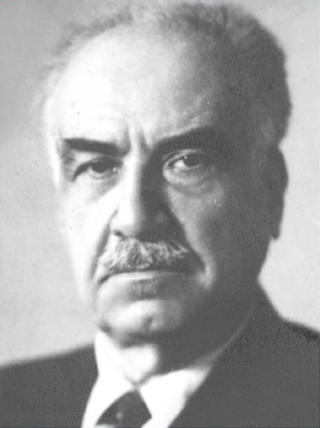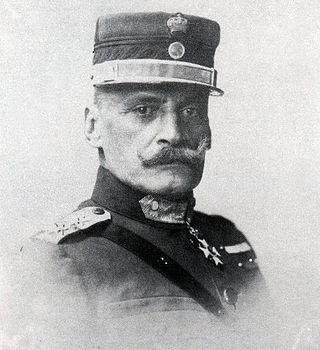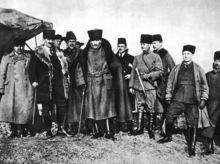
Mustafa İsmet İnönü was a Turkish army officer and statesman who served as the second president of Turkey from 11 November 1938, to 22 May 1950, and as its prime minister three times: from 1923 to 1924, 1925 to 1937, and 1961 to 1965.

The Greco-Turkish War of 1919–1922 was fought between Greece and the Turkish National Movement during the partitioning of the Ottoman Empire in the aftermath of World War I, between 15 May 1919 and 14 October 1922. This conflict was a part of the Turkish War of Independence.

The Battle of the Sakarya, also known as the Battle of the Sangarios, was an important engagement in the Greco-Turkish War (1919–1922).

Mustafa Fevzi Çakmak was a Turkish field marshal (Mareşal) and politician. He served as the Chief of General Staff from 1918 and 1919 and later the Minister of War of the Ottoman Empire in 1920. He later joined the provisional Government of the Grand National Assembly and became the Deputy Prime Minister, Minister of National Defense and later as the Prime Minister of Turkey from 1921 to 1922. He was the second Chief of the General Staff of the provisional Ankara Government and the first Chief of the General Staff of the Republic of Turkey.

The Battle of Dumlupınar, or known as Field Battle of the Commander-in-Chief in Turkey, was one of the important battles in the Greco-Turkish War (1919–1922). The battle was fought from 26 to 30 August 1922 near Dumlupınar, Kütahya in Turkey.

Anastasios Papoulas was a Greek general, most notable as the Greek commander-in-chief during most of the Greco-Turkish War of 1919–22. Originally a firm royalist, after 1922 he shifted towards the republican Venizelists, and was executed in 1935 for supporting a failed republican coup.

The Second Battle of İnönü was fought between March 23 and April 1, 1921 near İnönü in present-day Eskişehir Province, Turkey during the Greco-Turkish War (1919–22), also known as the western front of the larger Turkish War of Independence. It marked a turning point in the Greco-Turkish War and the Turkish War of Independence of which it was a part, as Greek forces had previously been victorious over mostly irregular Turkish forces and suffered their first major halt in Asia minor campaign.

İnönü is a municipality and district of Eskişehir Province, Turkey. Its area is 345 km2, and its population is 6,173 (2022). Its elevation is 840 m (2,756 ft).

The Turkish State Cemetery is a national and military cemetery in Ankara, Turkey, containing the graves of the presidents of Turkey and the high-ranked, close companions-in-arms of Mustafa Kemal Atatürk, the founder of the Republic of Turkey, in the Turkish War of Independence.

Çerkes Ethem, known in English as Ethem the Circassian, was a Circassian Ottoman guerilla leader, social bandit, efe and soldier. He initially gained fame for establishing the Kuva-yi Seyyare and putting down multiple large-scale rebellions and gaining key major victories against the Greek armies invading Anatolia during the Turkish War of Independence.

The Battle of Kütahya–Eskişehir, was fought between July 10 and July 24, 1921 when the Greek Army of Asia Minor clashed with the Turkish troops commanded by İsmet Pasha in defence of the line of Kara Hisâr-ı Sahib -Kütahya-Eskişehir.

The Kuva-yi Milliye were irregular Turkish militia forces active in the early period of the Turkish War of Independence. These irregular forces emerged after the occupation of the parts of Turkey by the Allied forces in accordance with the Armistice of Mudros. Later, Kuva-yi Milliye were integrated to the regular army of the Grand National Assembly. Some historians call this period (1918–20) of the Turkish War of Independence the "Kuva-yi Milliye phase".

Emine Mevhibe İnönü was the First Lady of Turkey from November 11, 1938, until May 27, 1950, during the presidency of her husband İsmet İnönü.

The Caucasus Army Group or Caucasian Army Group of the Ottoman Empire was one of the army groups of the Ottoman Army. It was formed during World War I.
On August 23, 1921, during the Battle of the Sakarya, the opposing armies were deployed as follows:

The Army of Asia Minor was a field army of the Hellenic Army which was stationed in Anatolia during the Greco-Turkish War of 1919–1922.

Museum of Independence is a history museum in Odunpazarı, Eskişehir, Turkey. Established in 2016, it is dedicated to the Turkish War of Independence.
İnönü Military Quarter and War Museum is a military and war museum in Turkey.
Parti Pehlivan after the Surname Law Mehmet Baskak was a Turkish wrestler and a guerilla leader in the Ottoman Empire of Bosniak decent, and an officer in the Turkish Army during World War I and the Turkish War of Independence. He was an important leader in Kuva-yi Milliye of the Aegean Region. After the declaration of the Turkish Republic he was granted land in Hacıhaliller, Manisa for his services and lived in Manisa until his death.

Kuvâ-yi Seyyâre, also known as the Green Army Society or the People's Branch was a force of Circassian and Abkhazian volunteers led by Çerkes Ethem against the Allied invasion forces during the Turkish War of Independence. The group saw themselves as a force to fight against "those who caused disturbance to the greater good of Anatolia". The forces put down several rebellions and played a big role in significantly slowing down the Greek army during the Greco-Turkish War (1919-1922). In time, as Ethem's Islamic socialist views clashed with the Turkish nationalism of Mustafa Kemal's Turkish National movement, he eventually cut ties with them, and was declared a traitor due to clashes with İsmet İnönü.
















